1990 VOLKSWAGEN TRANSPORTER weight
[x] Cancel search: weightPage 4 of 165

Downloaded from www.Manualslib.com manuals search engine
1
INSTRUMENT PANEL
Illustration instruments and controls
Warning and indicator light symbols
CONTROLS AND EQUIPMENT
Keys,
central locking system .... 7, 8
Doors 9
Rear lid 11
Windows, mirrors 12, 13 Safety belts, head restraints . . . .14,19
Seats 20 Luggage compartment, pedals . 28,29
Brakes, Transmission 29, 32 Differential lock 33
Automatic-transmission 35 Steering lock/ignition/starter switch . 38
Starting procedures 39 Instrument cluster 40
Warning/indicator lights 43 Switches 46 Emergency flasher 46
Light switch, turn signals .... 46,48
Cruise control 49
Windshield wipers 50 Ventilation/Heating 51
Air conditioning 54
Heater 57
Sliding roof 62
Roof-rack 68 VEHICLE OPERATION
Break-in period - and afterwards . . 69
Operate your vehicle safety 70
Operate your vehicle economically
and minimize pollution 72
Trailer towing 73 Driving with the all-wheel drive ... 75
VEHICLE CARE
Fuel tank, fuel supply 85,86
Vehicle care (exterior/interior) . . 90, 93 Maintenance, inspection intervals . . 95 Engine compartment lid,
engine compartment 97 Lubricants, engine oil 98,99
Engine oil filter 101
Transmission oil 102
Power steering 103
Cooling system 104 Brake fluid 108
Battery 109
Windshield washers/wipers . . . 112,113
Tires/wheels 114 Difficult operating conditions .... 120
Winter driving 121
Accessories 122
DO-IT-YOURSELF SERVICE
Jack and tools 123 Spare wheel 124
Changing a wheel 125 Fuses, bulbs 128, 130 Adjusting headlights
134
Installing,
replacing the radio . . . . 135
Emergency starting 136
Emergency towing 138
Lifting vehicle . . 140
TECHNICAL DESCRIPTION
Engine, transmission 142
Steering,
suspension, brakes,
body, chassis 143 Emission-control-system 144
TECHNICAL DATA
Engine, spark plugs .
V-belts capacities . . Dimensions
Weights
Vehicle identification 146
147
148
150 151
CONSUMER INFORMATION
Service manuals 152
GAS STATION INFORMATION
Location of servicing points 156
ALPHABETICAL INDEX 158
www.westfaliaT3.info - a useful website for owners and enthusiasts of VW Westfalia T25 / T3 Campervans
Page 22 of 165
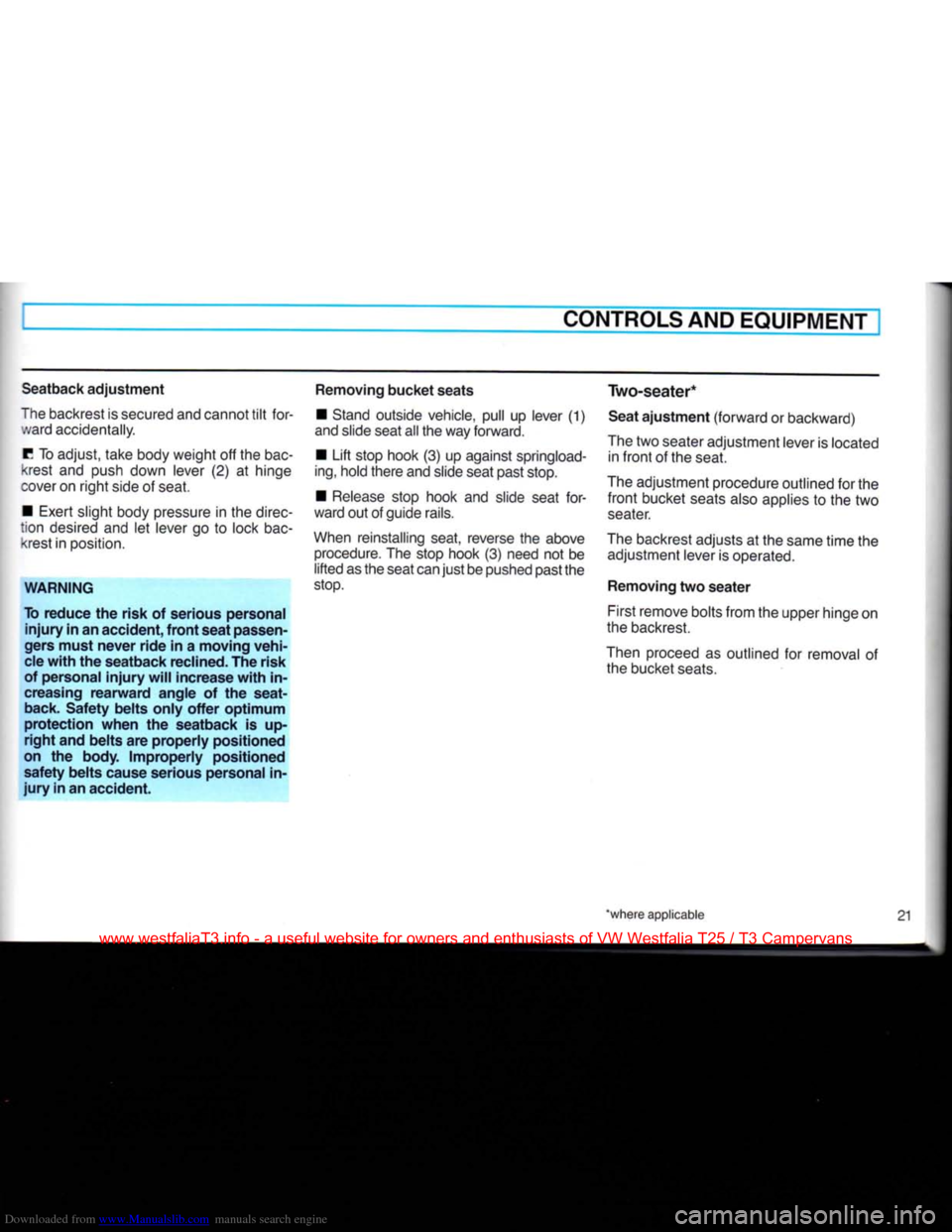
Downloaded from www.Manualslib.com manuals search engine
CONTROLS AND
EQUIPMENT
Seatback
adjustment
The backrest is secured and cannot
tilt
for
ward accidentally.
C
To adjust, take body weight off the
bac
krest and push down lever (2) at hinge
cover on
right
side of seat.
• Exert slight body pressure in the direc
tion
desired and let lever go to lock
bac
krest in position.
WARNING
To
reduce
the
risk
of
serious
personal
injury
in an
accident,
front
seat
passen
gers
must
never
ride
in a
moving
vehi
cle
with
the
seatback
reclined.
The
risk
of
personal
injury
will
increase
with
in
creasing
rearward
angle
of the
seat-
back.
Safety
belts
only
offer
optimum
protection
when
the
seatback
is up
right
and
belts
are
properly
positioned
on the
body.
Improperly
positioned
safety
belts
cause
serious
personal
in
jury
in an
accident.
Removing
bucket
seats
• Stand outside vehicle, pull up lever (1)
and slide seat all the way forward.
•
Lift
stop hook (3) up against springload-
ing,
hold there and slide seat past stop.
•
Release
stop hook and slide seat
for
ward out of guide rails.
When reinstalling seat, reverse the above procedure. The stop hook (3) need not be
lifted
as the seat can
just
be pushed past the
stop.
Two-seater*
Seat
ajustment
(forward
or backward)
The two seater adjustment lever is located in
front
of the seat.
The adjustment procedure outlined for the
front
bucket seats also applies to the two
seater.
The backrest adjusts at the same
time
the adjustment lever is operated.
Removing
two
seater
First remove bolts
from
the upper hinge on
the backrest.
Then proceed as outlined for removal of the bucket
seats.
*where applicable 21
www.westfaliaT3.info - a useful website for owners and enthusiasts of VW Westfalia T25 / T3 Campervans
Page 29 of 165
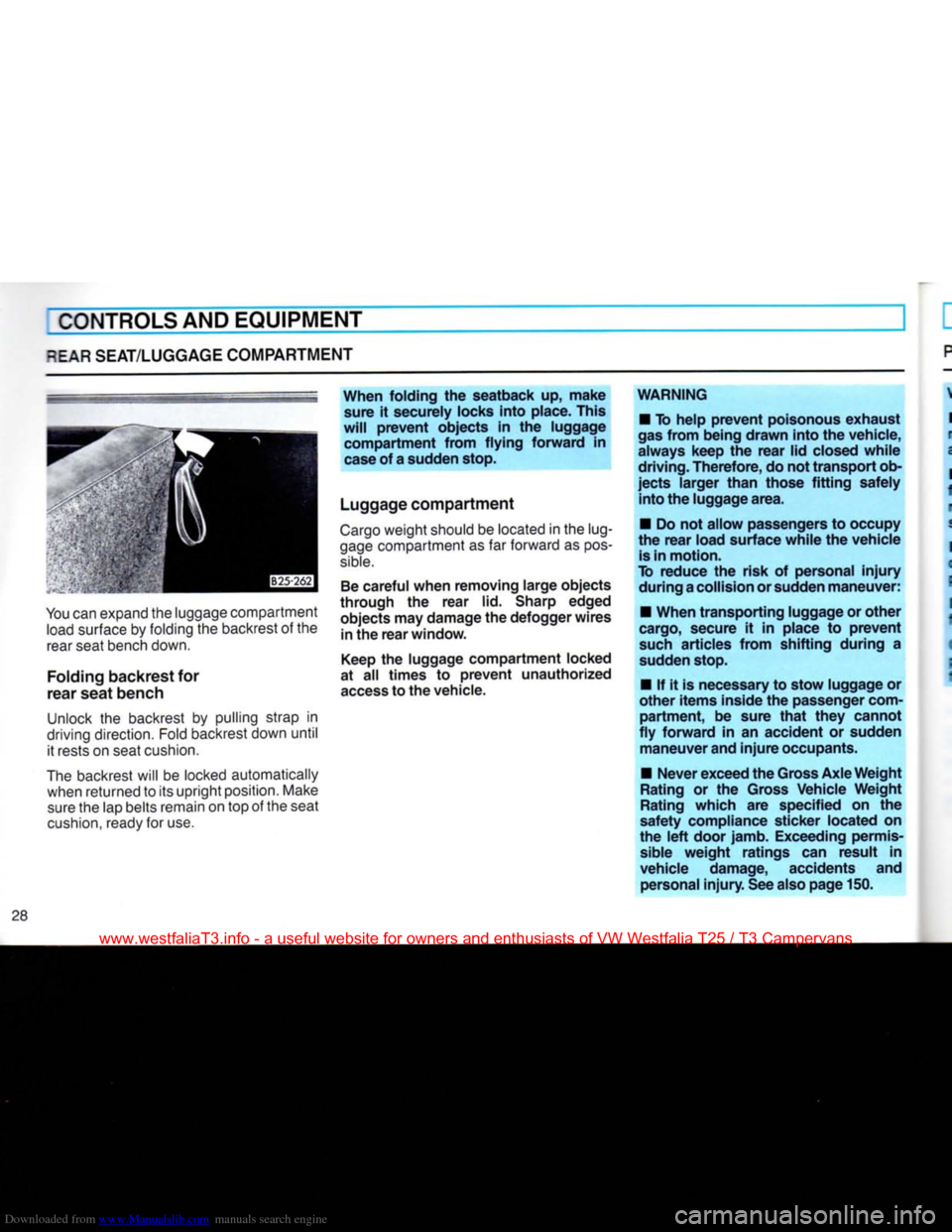
Downloaded from www.Manualslib.com manuals search engine
CONTROLS
AND
EQUIPMENT
^EAR SEAT/LUGGAGE COMPARTMENT
You can expand the luggage compartment
load
surface
by
folding
the
backrest
of the
rear seat bench down.
Folding
backrest for
rear seat bench
Unlock
the
backrest
by
pulling strap
in
driving direction. Fold backrest down until it rests
on
seat cushion.
The backrest will
be
locked automatically when returned
to
its upright position. Make sure the lap belts remain
on
top
of
the seat
cushion,
ready
for
use. When folding
the
seatback
up,
make
sure
it
securely locks into place.
This
will
prevent
objects
in the
luggage compartment from flying forward
in
case
of
a
sudden stop.
Luggage compartment
Cargo weight should
be
located
in the
lug
gage compartment
as far
forward
as
pos
sible.
Be
careful when removing large objects
through
the
rear
lid.
Sharp edged objects may damage the defogger wires in the rear window.
Keep
the
luggage compartment locked
at
all
times
to
prevent
unauthorized
access
to the vehicle. WARNING
•
To
help
prevent
poisonous exhaust
gas from being drawn into the vehicle,
always keep
the
rear lid closed while
driving. Therefore, do not transport ob
jects larger than those fitting safely into the luggage
area.
•
Do
not allow passengers to occupy
the rear load surface while the vehicle
is
in motion.
To reduce
the
risk
of
personal
injury
during
a
collision
or sudden maneuver:
•
When transporting luggage or other
cargo, secure
it in
place
to
prevent
such articles from shifting during
a
sudden stop.
•
If it is
necessary to stow luggage
or
other items inside the passenger
com
partment,
be
sure that
they
cannot
fly forward
in an
accident
or
sudden maneuver
and
injure occupants.
•
Never
exceed the Gross Axle Weight
Rating
or the
Gross Vehicle Weight
Rating
which
are
specified
on the
safety compliance sticker located
on
the left door jamb. Exceeding permis
sible
weight ratings
can
result
in
vehicle damage, accidents
and
personal
injury.
See also page
150.
www.westfaliaT3.info - a useful website for owners and enthusiasts of VW Westfalia T25 / T3 Campervans
Page 36 of 165
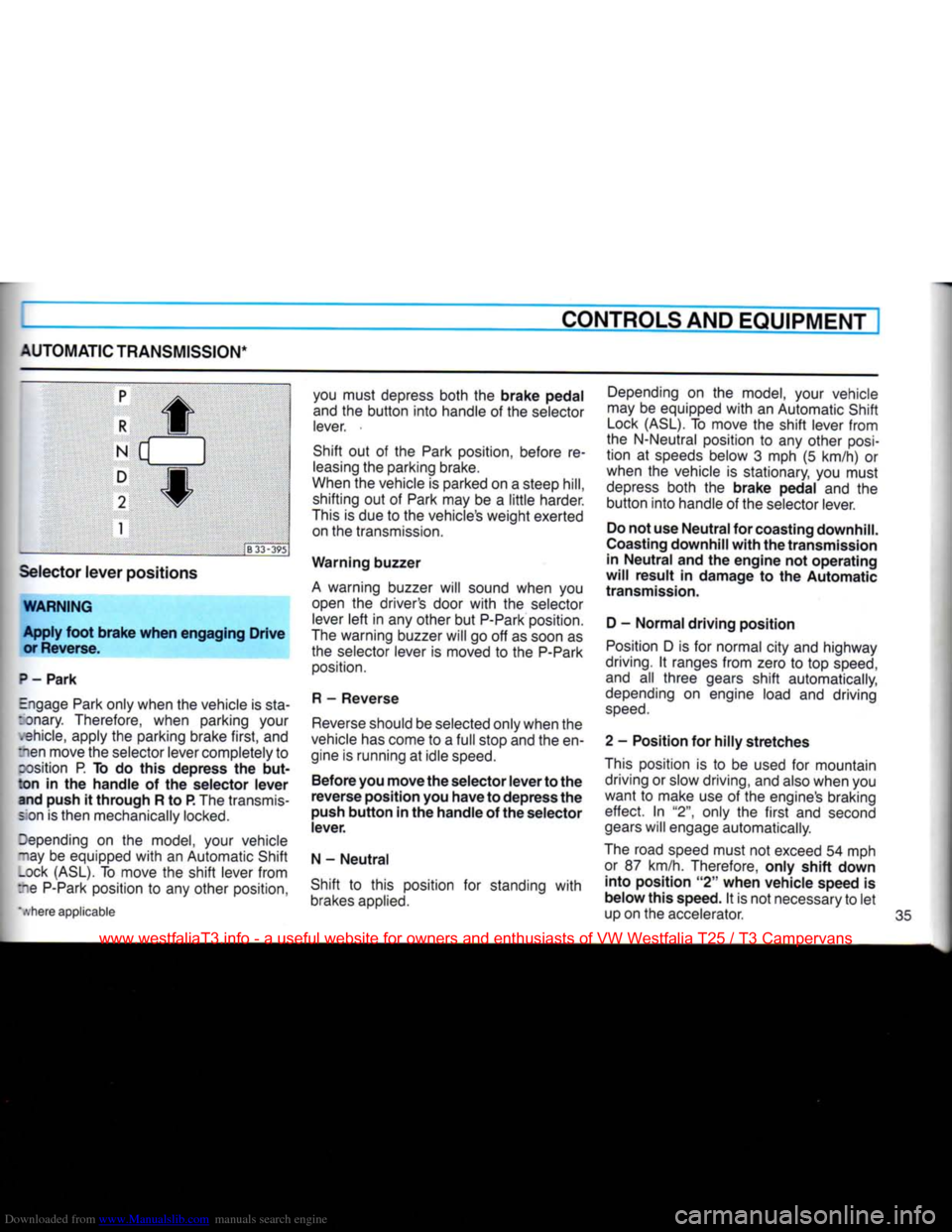
Downloaded from www.Manualslib.com manuals search engine
CONTROLS AND EQUIPMENT
AUTOMATIC TRANSMISSION*
p R
f
N d
D
2
f
1 :'B33-395
Selector lever positions
WARNING Apply foot brake when engaging Drive or Reverse.
P - Park
Engage Park only when the vehicle is
sta
nnary. Therefore, when parking your .snide, apply the parking brake first, and
:nen move the selector lever completely to cosition P. To do this depress the but
ton in the handle of the selector lever and push it through R to P. The transmis-s on is then mechanically locked.
Depending on the model, your vehicle
~iay be equipped with an Automatic Shift _ock (ASL). To move the shift lever from
re
P-Park
position to any other position,
".vhere applicable you must depress both the brake pedal
and the button into handle of the selector lever.
Shift out of the Park position, before re leasing the parking brake.
When the vehicle is parked on a steep
hill,
shifting out of Park may be a little harder.
This is due to the vehicle's weight exerted on the transmission.
Warning buzzer
A warning buzzer will sound when you open the driver's door with the selector lever left in any other but
P-Park
position.
The warning buzzer will go off as soon as the selector lever is moved to the
P-Park
position.
R - Reverse
Reverse should be selected only when the
vehicle has come to a full stop and the en
gine is running at idle speed.
Before you move the selector lever to the
reverse position you have to depress the
push button in the handle of the selector
lever.
N - Neutral
Shift to this position for standing with
brakes applied. Depending on the model, your vehicle
may be equipped with an Automatic Shift
Lock (ASL). To move the shift lever from
the N-Neutral position to any other
posi
tion at speeds below 3 mph (5 km/h) or when the vehicle is stationary, you must
depress both the brake pedal and the button into handle of the selector lever.
Do not use Neutral for coasting downhill.
Coasting downhill with the transmission in Neutral and the engine not operating
will result in damage to the Automatic
transmission.
D - Normal driving position
Position D is for normal city and highway
driving.
It ranges from zero to top speed, and all three gears shift automatically,
depending on engine load and driving
speed.
2 - Position for hilly stretches
This position is to be used for mountain driving or slow driving, and also when you
want to make use of the engine's braking effect. In "2", only the first and second
gears will engage automatically.
The road speed must not exceed 54 mph or 87 km/h. Therefore, only shift down into position "2" when vehicle speed is
below this speed. It is not necessary to let
up on the accelerator. 35
www.westfaliaT3.info - a useful website for owners and enthusiasts of VW Westfalia T25 / T3 Campervans
Page 57 of 165
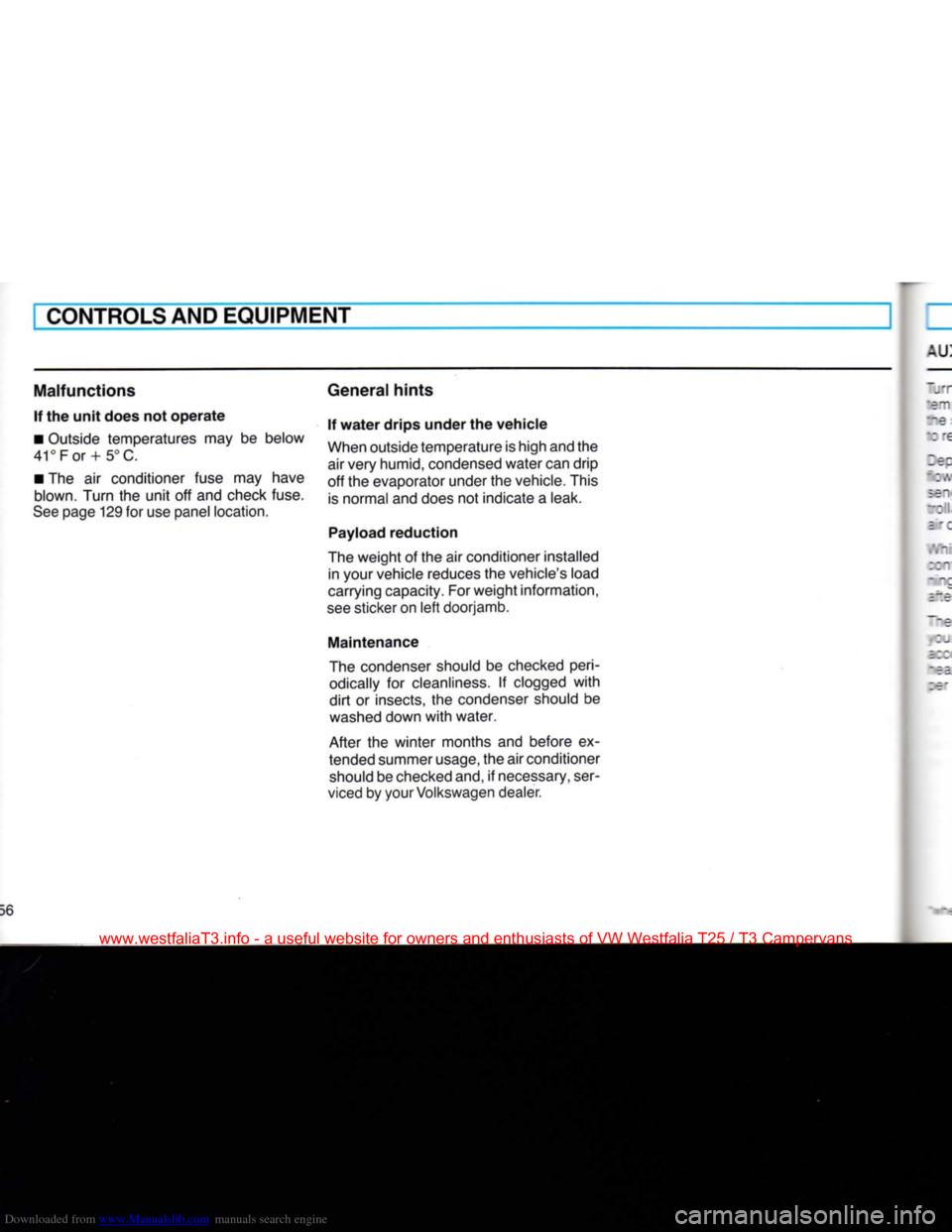
Downloaded from www.Manualslib.com manuals search engine
CONTROLS AND
EQUIPMENT
Malfunctions
if the
unit
does not
operate
• Outside temperatures may be below
41° For + 5°C.
• The air conditioner fuse may have blown. Turn the
unit
off and check fuse.
See
page 129 for use panel location.
General
hints
If
water
drips
under
the
vehicle
When outside temperature is high and the
air very humid, condensed water can drip
off the evaporator under the vehicle. This
is
normal and does not indicate a leak.
Payload
reduction
The weight of the air conditioner installed in your vehicle reduces the vehicle's load
carrying capacity. For weight information,
see
sticker on
left
doorjamb.
Maintenance
The condenser should be checked peri
odically for cleanliness. If clogged
with
dirt
or insects, the condenser should be
washed down
with
water.
After the winter months and before ex
tended summer
usage,
the air conditioner should be checked and, if necessary, ser
viced by your Volkswagen dealer.
www.westfaliaT3.info - a useful website for owners and enthusiasts of VW Westfalia T25 / T3 Campervans
Page 73 of 165
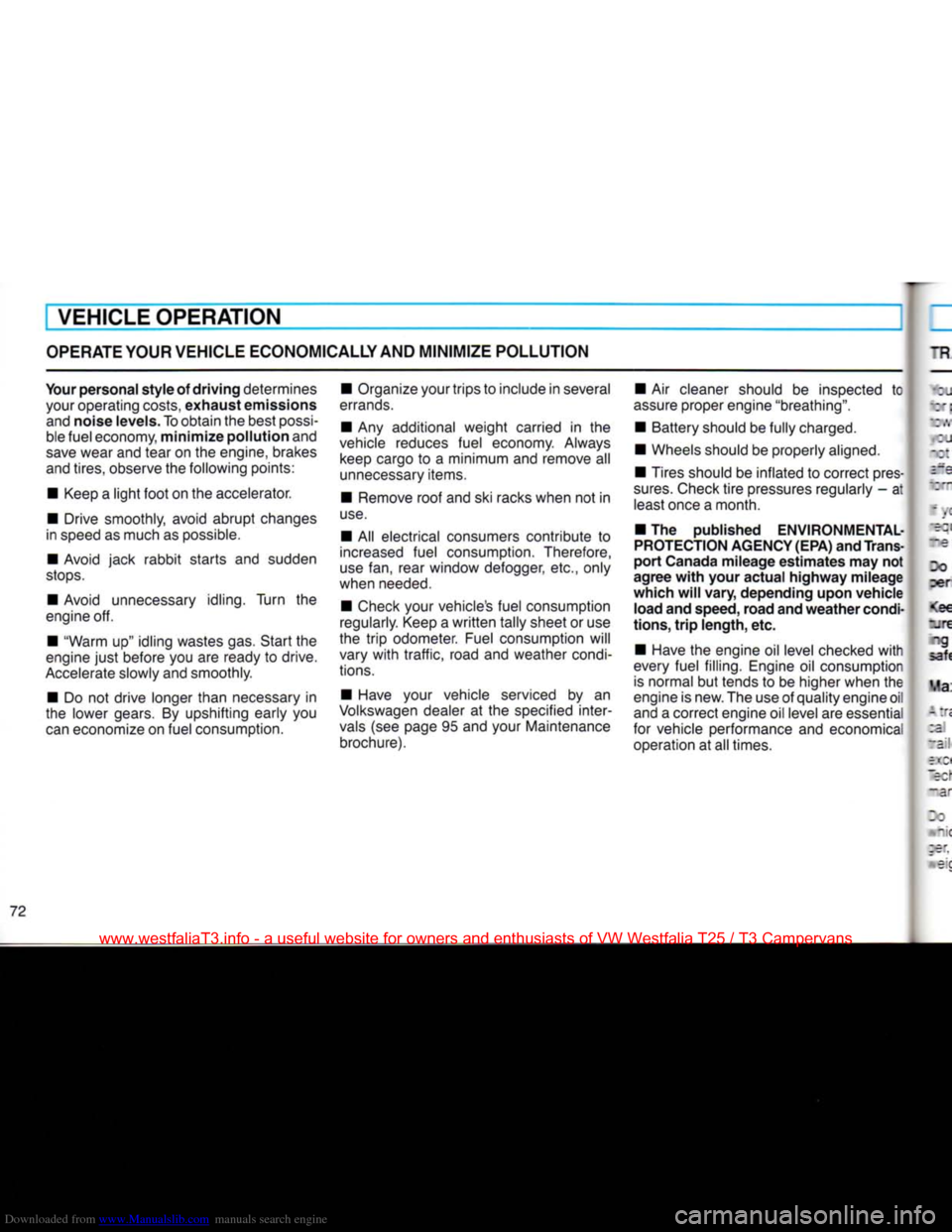
Downloaded from www.Manualslib.com manuals search engine
VEHICLE OPERATION
OPERATE
YOUR VEHICLE ECONOMICALLY AND
MINIMIZE
POLLUTION
Your
personal
style
of
driving
determines your operating costs,
exhaust
emissions and noise levels. To obtain the best
possi
ble fuel economy,
minimize
pollution
and
save
wear and tear on the engine, brakes
and tires, observe the following points:
• Keep a
light
foot
on the accelerator.
• Drive smoothly, avoid abrupt changes
in speed as much as possible.
• Avoid jack rabbit starts and sudden
stops.
• Avoid unnecessary idling. Turn the
engine off.
• "Warm up" idling wastes gas. Start the
engine
just
before you are ready to drive.
Accelerate
slowly and smoothly.
• Do not drive longer than necessary in
the lower gears. By upshifting early you
can
economize on fuel consumption. • Organize your trips to include in several
errands.
• Any additional weight carried in the
vehicle reduces fuel economy. Always keep cargo to a minimum and remove all
unnecessary
items.
• Remove roof and ski racks when not in
use.
• All electrical consumers contribute to
increased
fuel consumption. Therefore,
use
fan, rear window defogger, etc., only
when needed.
• Check your vehicle's fuel consumption
regularly. Keep a
written
tally sheet or use
the
trip
odometer. Fuel consumption will
vary
with
traffic, road and weather condi
tions.
• Have your vehicle serviced by an
Volkswagen
dealer at the specified inter
vals
(see page 95 and your Maintenance brochure). • Air cleaner should be inspected to
assure
proper engine "breathing".
• Battery should be fully charged.
• Wheels should be properly aligned.
• Tires should be inflated to correct pres
sures.
Check
tire
pressures regularly - at least once a month.
• The published ENVIRONMENTAL-
PROTECTION AGENCY (EPA) and Trans
port
Canada
mileage
estimates
may not
agree
with
your
actual
highway
mileage
which
will
vary,
depending
upon
vehicle
load
and speed,
road
and
weather
condi
tions,
trip
length,
etc.
• Have the engine oil level checked
with
every fuel filling. Engine oil consumption
is
normal but tends to be higher when the
engine is new. The use of quality engine oil
and a correct engine oil level are essential
for vehicle performance and economical operation at all times.
72
www.westfaliaT3.info - a useful website for owners and enthusiasts of VW Westfalia T25 / T3 Campervans
Page 74 of 165
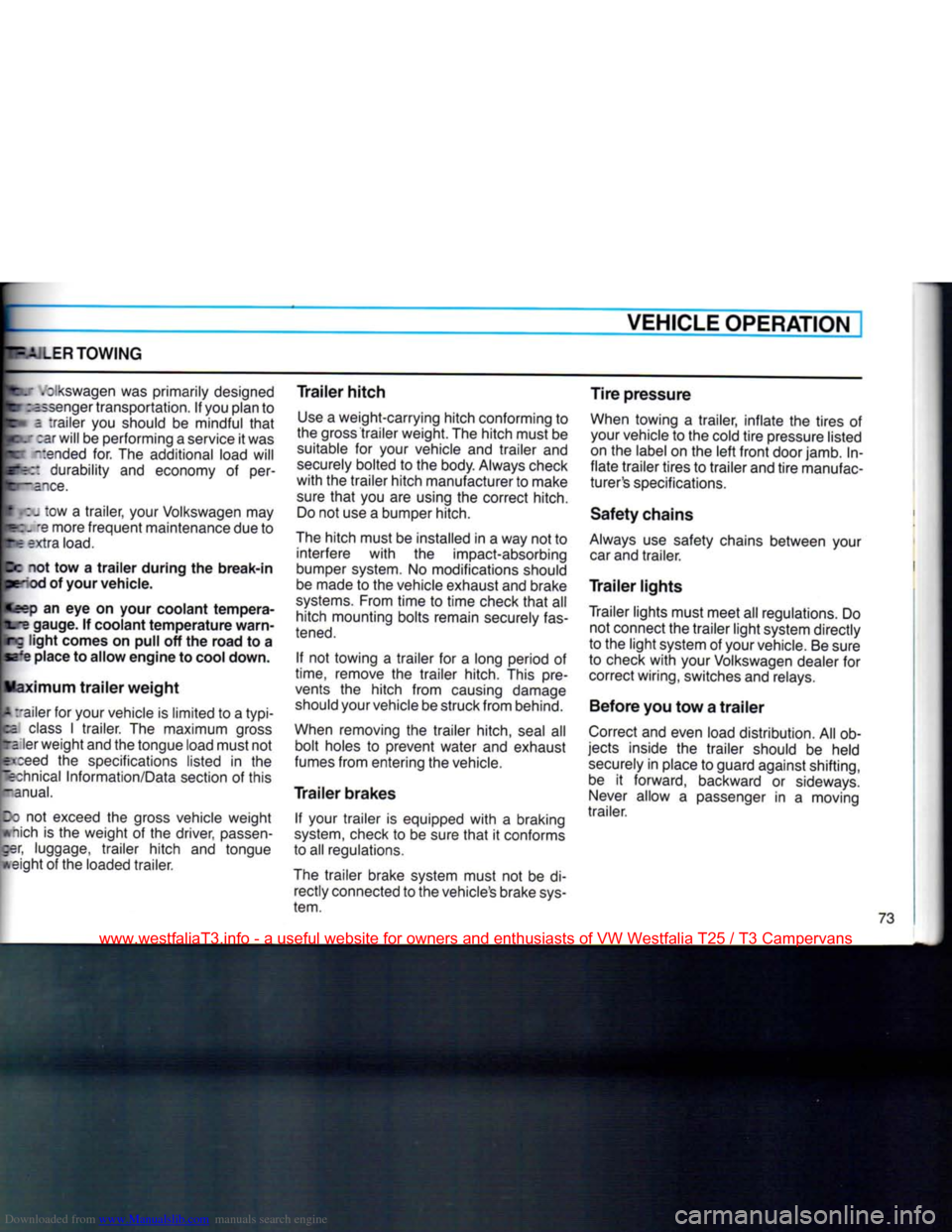
Downloaded from www.Manualslib.com manuals search engine
iLER TOWING
VEHICLE OPERATION
phLT .'jlkswagen was primarily designed
pr : assenger transportation. If you plan to
m*
B.
trailer you should be mindful that
MLT
:ar will be performing a service it was
•cr "tended for. The additional load will
Wee durability and economy of per-
m~ ance. • :. :ow a trailer, your Volkswagen may
mc. -9 more frequent maintenance due to
ft* extra
load.
Gc not tow a trailer during the break-in kriod of your vehicle.
Keep an eye on your coolant tempera-
fere gauge. If coolant temperature warn- rc light comes on pull off the road to a sa's place to allow engine to cool down.
Maximum trailer weight
A vailer for your vehicle is limited to a
typi-
ca class I trailer. The maximum gross
Bier weight and the tongue load must not
eoeed the specifications listed in the
[fechnical Information/Data section of this
ranual.
Do not exceed the gross vehicle weight
•rhich is the weight of the driver, passen ger, luggage, trailer hitch and tongue
weight of the loaded trailer. Trailer hitch
Use a weight-carrying hitch conforming to
the gross trailer weight. The hitch must be suitable for your vehicle and trailer and
securely bolted to the body. Always check
with the trailer hitch manufacturer to make
sure that you are using the correct hitch. Do not use a bumper hitch.
The hitch must be installed in a way not to interfere with the impact-absorbing
bumper system. No modifications should
be made to the vehicle exhaust and brake
systems. From time to time check that all hitch mounting bolts remain securely fas
tened.
If not towing a trailer for a long period of
time,
remove the trailer hitch. This pre
vents the hitch from causing damage should your vehicle be struck from behind.
When removing the trailer hitch, seal all bolt holes to prevent water and exhaust
fumes from entering the vehicle.
Trailer brakes If your trailer is equipped with a braking
system,
check to be sure that it conforms
to all regulations.
The trailer brake system must not be di rectly connected to the vehicle's brake sys
tem.
Tire pressure
When towing a trailer, inflate the tires of
your vehicle to the cold tire pressure listed on the label on the left front door jamb. In
flate trailer tires to trailer and tire manufac
turer's specifications.
Safety chains
Always use safety chains between your car and trailer.
Trailer lights
Trailer lights must meet all regulations. Do not connect the trailer light system directly
to the light system of your vehicle. Be sure
to check with your Volkswagen dealer for
correct wiring, switches and relays.
Before you tow a trailer
Correct and even load distribution. All ob
jects inside the trailer should be held securely in place to guard against shifting, be it forward, backward or sideways.
Never allow a passenger in a moving
trailer.
www.westfaliaT3.info - a useful website for owners and enthusiasts of VW Westfalia T25 / T3 Campervans
Page 75 of 165
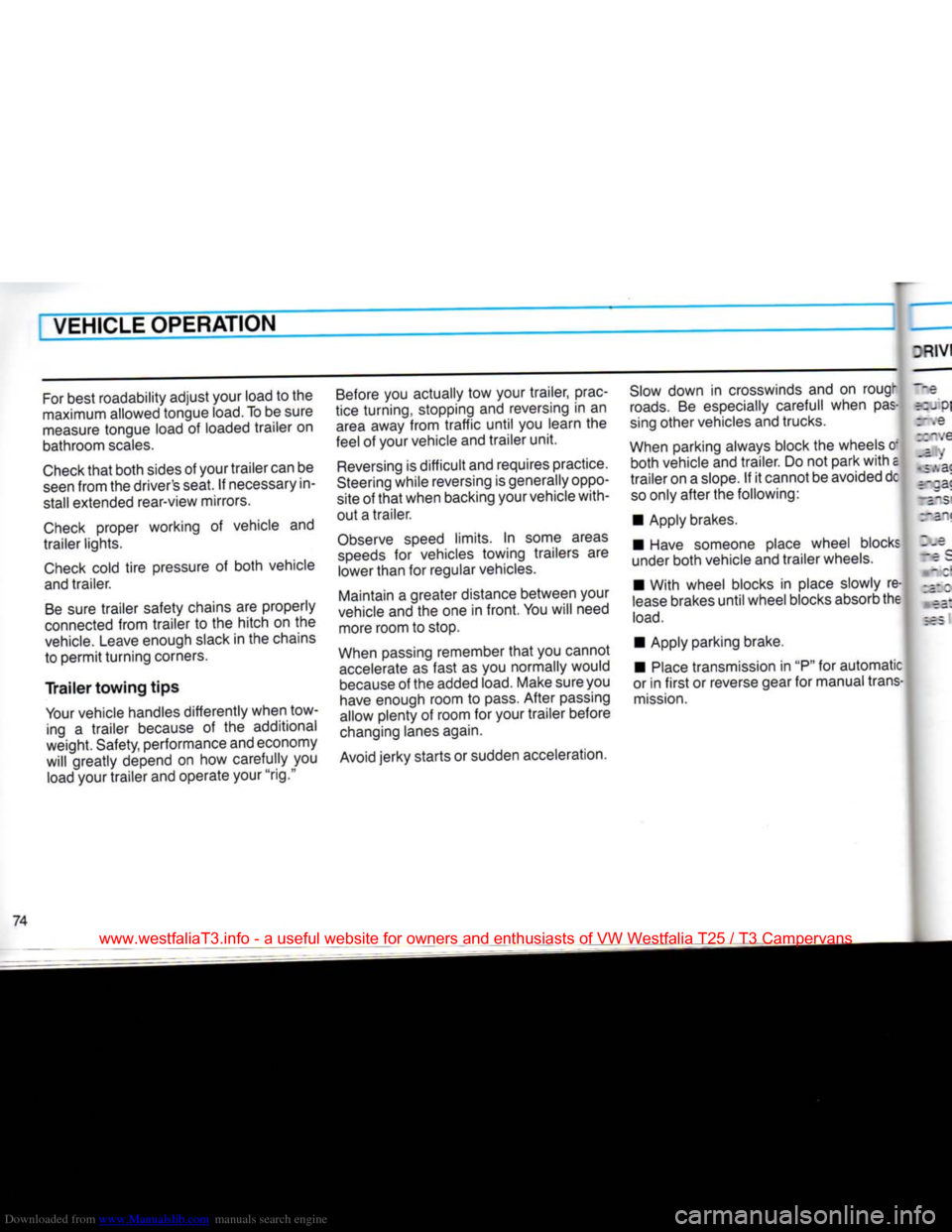
Downloaded from www.Manualslib.com manuals search engine
VEHICLE OPERATION
For
best roadability adjust your load to the
maximum allowed tongue load. To be sure
measure
tongue load of loaded trailer on
bathroom
scales.
Check
that
both sides of your trailer can be
seen
from the driver's seat. If necessary in
stall extended rear-view mirrors.
Check
proper working of vehicle and
trailer lights.
Check
cold
tire
pressure of both vehicle
and
trailer.
Be
sure trailer safety chains are properly
connected
from trailer to the hitch on the
vehicle.
Leave enough slack in the chains
to permit turning corners.
Trailer
towing
tips
Your
vehicle handles differently when tow ing a trailer because of the additional
weight. Safety, performance and economy
will greatly depend on how carefully you
load
your trailer and operate your "rig."
Before
you actually tow your trailer, prac
tice turning, stopping and reversing in an
area
away from
traffic
until
you learn the
feel of your vehicle and trailer
unit.
Reversing
is
difficult
and requires practice.
Steering
while reversing is generally oppo
site of
that
when backing your vehicle with
out a trailer.
Observe
speed limits. In some areas
speeds
for vehicles towing trailers are lower than for regular vehicles.
Maintain a greater distance between your
vehicle
and the one in
front.
You will need more room to stop.
When
passing remember
that
you cannot
accelerate
as fast as you normally would
because
of the added load. Make sure you
have
enough room to
pass.
After passing
allow plenty of room for your trailer before
changing
lanes again.
Avoid
jerky starts or sudden acceleration.
Slow
down in crosswinds and on rougi"
roads.
Be especially carefull when
pas
sing
other vehicles and trucks.
When
parking always block the wheels o: both vehicle and trailer. Do not park
with
a
trailer on a slope. If it cannot be avoided dc
so
only after the following:
• Apply brakes.
• Have someone place wheel blocks
under both vehicle and trailer wheels.
• With wheel blocks in place slowly re
lease
brakes
until
wheel blocks absorb the
load.
• Apply parking brake.
•
Place
transmission in
"P"
for automatic
or in
first
or reverse gear for manual trans
mission.
74
www.westfaliaT3.info - a useful website for owners and enthusiasts of VW Westfalia T25 / T3 Campervans